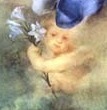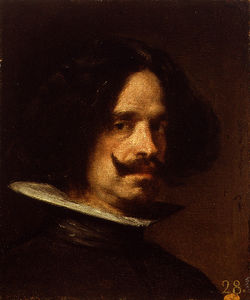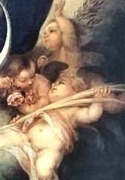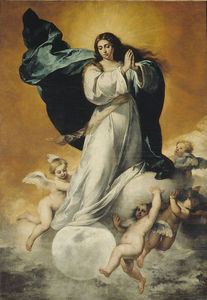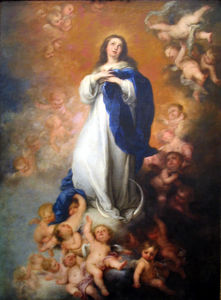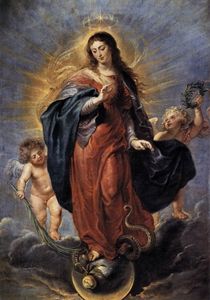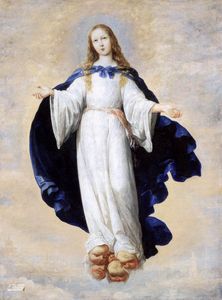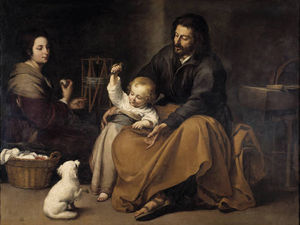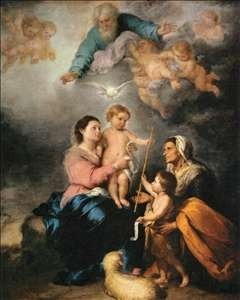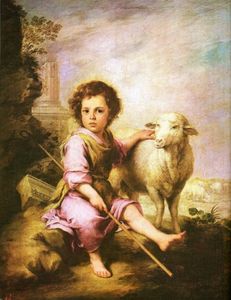Immaculate Conception of El Escorial
- Date of Creation:
- 1660
- Alternative Names:
- Immaculate Conception
- Height (cm):
- 222.00
- Length (cm):
- 118.00
- Medium:
- Oil
- Support:
- Canvas
- Subject:
- Figure
- Art Movement:
- Baroque
- Created by:
- Current Location:
- Madrid, Spain
- Displayed at:
- Museo Nacional del Prado
- Owner:
- Museo Nacional del Prado
- Immaculate Conception of El Escorial Page's Content
- Story / Theme
- Analysis
- Related Paintings
- Artist
- Art Period
- Bibliography
Immaculate Conception of El Escorial Story / Theme
Immaculate Conception of El Escorial is one of several versions Murillo executed of this theme, but this version is widely considered to be the very highlight of his oeuvre. The doctrine of the Immaculate Conception holds that the Virgin Mary, the pure vessel that would carry Jesus Christ, was conceived without original sin, like the rest of mankind.
The theory arose in the Middle Ages but remained controversial throughout the history of Christianity, with the Church fathers reluctant to accept the doctrine (in fact, the Immaculate Conception didn't become Church dogma until 1854).
During the Counter-Reformation, many Catholics retaliated by loudly reaffirming their faith in the Immaculate Conception and thus during the Baroque period the theme became quite popular in Italian and Spanish painting. Seville in particular was a locust of activity for supporters of the dogma, and when in 1613 a sermon was delivered expressing doubts as to the verity of the Immaculate Conception, the entire city erupted. Massive demonstrations organized by the city fathers brought over 40,000 citizens into the streets to loudly proclaim that Mary was born without original sin.
After this scandal, the Immaculate Conception became even more popular in Spanish art, appearing notably in the oeuvre of Zurbarán and Velázquez. In 1661, the Spaniards finally managed to push the Pope to issue a papal bull to clarify the issue.
The iconography of the Immaculate Conception was initially difficult for artists to agree upon, but was relatively codified by the 17th century. The depiction of the Virgin Mary in this context is taken from John of Patmos's Book of Revelations, where he describes "A woman robed with sun, beneath her feet the moon, and on her head a crown of twelve stars. " This became the standard iconography for artists, who were also inspired by Portuguese saint Beatriz de Silva's vision of the Immaculate Conception.
The Commission:
Murillo's many version of The Immaculate Conception were commissioned by various religious orders, particularly the Franciscan Order, of which he was a member.
Immaculate Conception of El Escorial Analysis
Immaculate Conception of El Escorial is widely acknowledged as one of the supreme achievements of Murillo's oeuvre, and the painting is representative of Murillo's treatment of the theme elsewhere. Murillo's Immaculate Conception is particularly notable for the following characteristics;
Composition:
The pose:
Almost all of Murillo's paintings of the Immaculate Conception evidence the same pose: the Virgin Mary is posed demurely on the crescent moon, her hands clasped in front of her bosom, gazing sweetly heavenwards (this upwards motion is also a reference to the closely related iconography of the Assumption of the Virgin).
The outfit:
Murillo always has his Virgin of the Immaculate Conception clad in a white robe with a blue drapery, as Pacheco recommends.
The moon:
The crescent moon is an essential part of the iconography of the Immaculate Conception, because the moon was traditionally a symbol of the purity of the Virgin Mary. Furthermore, the crescent moon is also a symbol of Islam and hence, for 17th century Catholics, of heresy; by standing upon the crescent moon, therefore, the Virgin tramples upon heresy.
The Virgin is most commonly shown standing on the crescent moon, but Murillo did execute one unusual version of the theme where the Virgin surmounts a full moon.
Use of lighting:
Unlike the clear, bold lighting in Rubens's or Reni's versions of this theme, Murillo employs a delicate, smoky chiaroscuro and a soft, golden light. Indeed, in this version of the Immaculate Conception, the Virgin is bathed in a hazy cloud of golden celestial light that lends the painting an unusual warmth and sweetness.
Sweet babies:
Murillo is famous for his paintings of children, and the delicate, hallmark-card cuteness of the baby angels in The Immaculate Conception are a testament to the artist's love for this subject. These pudgy putti are amongst the most sentimental representations of the subject in the entire history of art.
Immaculate Conception of El Escorial Related Paintings
Immaculate Conception of El Escorial Artist
Religious works dominate Murillo's oeuvre by far, and it is for these paintings that Murillo is the most famous. His innumerable representations of the Virgin Mary, the Holy Family, and various scenes from the Bible and the lives of the saints are notable for their intimate, domestic sweetness, so distinct from Zurbarán's severe, ascetic piety.
Murillo may have painted more versions of the Immaculate Conception than any other artist. The doctrine of the Immaculate Conception held that the Virgin Mary, as the mother of Christ, was completely pure and born without original sin. This doctrine had existed since the Middle Ages but wasn't officially accepted in Church doctrine until the 19th century, and Seville was the European center of agitation for those fighting for this belief. This theme was thus particularly popular amongst Sevillian artists.
Murillo's several versions of the Immaculate Conception are particularly notable for the fluffy, cotton-candy like clouds, multitudes of pudgy puttis, and an overall softness and sweetness of expression.
Murillo was wildly popular in his own lifetime, and even more so during the Rococo period of the first half of the 18th century. In fact, the demand for Murillo's paintings abroad during this period was so great, the Spanish king was forced to place a moratorium on their export.
By the end of the 18th century, however, Murillo's favor slowly began to wane. The artist's seemingly frivolous sentimentality and what was interpreted as a uniquely Spanish sensuality did not gel with Neoclassical sensibilities, and by the 19th century, copies and imitations of Murillo's paintings were so ubiquitous, the public frankly grew tired of the artist.
By the end of the 19th century and beginning of the 20th, Murillo was dismissed as "weak" and essentially inconsequential in favor of Velázquez, and the artist virtually disappeared from the art history books.
Fortunately, Murillo's reputation has slowly come to be rehabilitated as art historians and museum curators begin to re-evaluate the artist's role in Baroque art.
Immaculate Conception of El Escorial Art Period
Murillo was the last great painter of the Spanish Golden Age. During the 17th century, Spain saw her greatest artists and some of her greatest literature and drama in the nation's entire history; unfortunately, this century also saw Spain's worst political defeats and economic and natural disasters, including plague, earthquakes, poverty and famine.
The orphaned street urchins and impoverished characters of Murillo's genre scenes were thus the hard reality of the artist's times (although the artist's depiction of such figures has been generously sweetened and idealized). Murillo's paintings bridge the dark drama and sometimes ascetic simplicity of Spain's early Baroque artists and the fanciful sensuality of the approaching Rococo era.
In his early career, Murillo was deeply influenced by the most prominent painter in Seville at the time, Zurbarán: from the master, the younger artist learned the expressive power of chiaroscuro as well as a predilection for relatively neutral, highly compressed pictorial space.
After visiting Madrid in 1658, however, Murillo discovered a new artist who would have a profound influence on the further development of his style: Peter Paul Rubens, who along with other painters represented in the Spanish royal collection showed Murillo the powerful potential of using a bright, bold palette and dynamic, expressive brushwork.
Yet, one of the most significant influences on Murillo was the pioneer of the Italian Baroque, Federico Barocci, who was completely overlooked by other Spanish painters of the Baroque era, but who was cherished by Murillo for the cheerful, sweet softness of his style.
Immaculate Conception of El Escorial Bibliography
For further information about Murillo, please refer to the recommended reading list below.
• Bartolomé Esteban Murillo, 1617-1682. Wedenfeld and Nicolson, 1982
• Brooke, Xanthe, and Peter Cherry. Murillo. Merrell, 2001
• Brown, Jonathan. The Golden Age of Painting in Spain. Yale University Press, 1991
• Davies, E. The Life of B. Esteban Murillo: Compiled from the Writings of Various Authors. London, 1819
• Kagane, Ludmilla. Murillo: The 17th Century Spanish Master. Parkstone Press, 1997
• Keysor, Jennie Ellis. Great Artists: Raphael, Rubens, Murillo, and Dürer. Educational Publishing Company, 1899
• Mallory, Nina A. El Greco to Murillo: Spanish Painting in the Golden Age: 1556-1770. Harper Collins, 1990
• Stratton-Pruitt, Suzanne. Bartolomé Esteban Murillo, Paintings 1617-1682: Paintings from American Collections. Harry N. Abrams, 2002
• Taggard, Mindy Nancarrow. Murillo's Allegories of Salvation and Triumph: The Parable of the Prodigal Son and the Life of Jacob. University of Missouri Press, 1992



